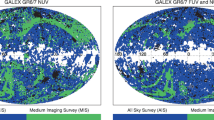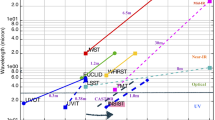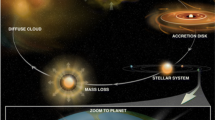Abstract
One of the key goals of NASA’s astrophysics program is to answer the question: How did galaxies evolve into the spirals and elliptical galaxies that we see today? We describe a space mission concept called Galaxy Evolution Spectroscopic Explorer (GESE) to address this question by making a large spectroscopic survey of galaxies at a redshift, z∼1 (look-back time of ∼8 billion years). GESE is a 1.5-m space telescope with an ultraviolet (UV) multi-object slit spectrograph that can obtain spectra of hundreds of galaxies per exposure. The spectrograph covers the spectral range, 0.2–0.4 μm at a spectral resolving power, R∼500. This observed spectral range corresponds to 0.1–0.2 μm as emitted by a galaxy at a redshift, z=1. The mission concept takes advantage of two new technological advances: (1) light-weighted, wide-field telescope mirrors, and (2) the Next-Generation MicroShutter Array (NG-MSA) to be used as a slit generator in the multi-object slit spectrograph.


Similar content being viewed by others
References
Astro-2010 Committee. http://www.nap.edu/catalog.php?record_id=12951 (2010)
Ellis, R., et al.: Extragalactic science and cosmology with the Subaru prime focus spectrograph (2012). arXiv:1206.0737v2
Ferguson, H., et al.: The size distribution of high-redshift galaxies. Astrophys. J. 600, L107 (2004)
Gunn, J., et al.: Understanding the astrophysics of galaxy evolution: the role of spectroscopic surveys in the next decade. arXiv:0903.3404v2 (2009)
Hull, T., Westerhoff, T., Lays, A., Pepi, J.: Practical aspects of specification of extreme lightweight Zerodur mirrors for spaceborne missions. In: SPIE, vol. 8836, p. 883607 (2013)
Jouvel, S., Kneib, J.-P., Ilbert, O., et al.: Designing future dark energy space missions. I. Building realistic galaxy spectro-photometric catalogs and their first applications. Astron. Astrophys. 504, 359 (2009)
Pettini, M., Steidel, C., Adelburger, K., et al.: The spectrum of MS 1512-cB58: an insight into Lyman-break galaxies. Astrophys. J. 528, 96 (2000)
Space Telescope Science Institute (STScI), Hubble Space Telescope Wide Field Camera 3. http://www.stsci.edu/hst/wfc3/design/at_a_glance/ (2013)
Zamkotsian, F., et al.: The DMD-based spectrograph on Galileo telescope. In: Proc. SPIE, vol. 8618, p. 86180E-1 (2013)
Author information
Authors and Affiliations
Corresponding author
Rights and permissions
About this article
Cite this article
Heap, S.R., Gong, Q., Hull, T. et al. GESE: a small UV space telescope to conduct a large spectroscopic survey of z∼1 Galaxies. Astrophys Space Sci 354, 211–214 (2014). https://doi.org/10.1007/s10509-014-1981-0
Received:
Accepted:
Published:
Issue Date:
DOI: https://doi.org/10.1007/s10509-014-1981-0




